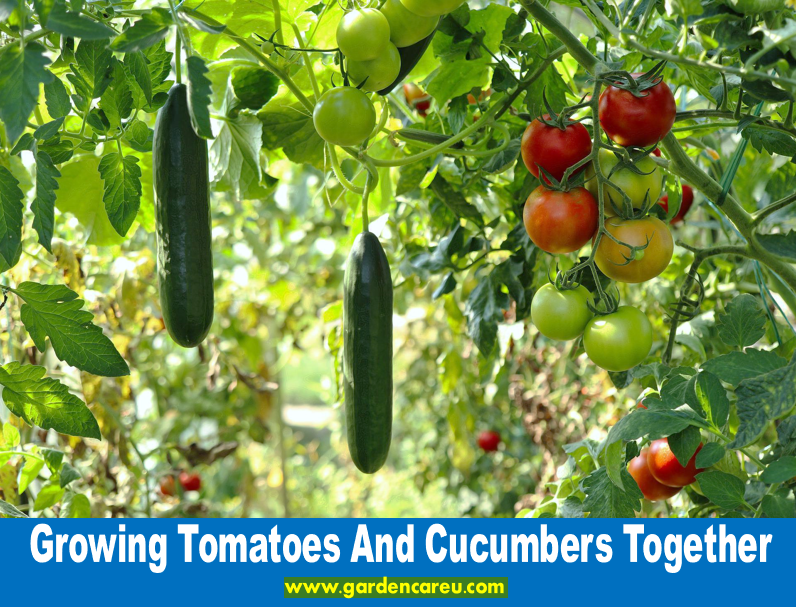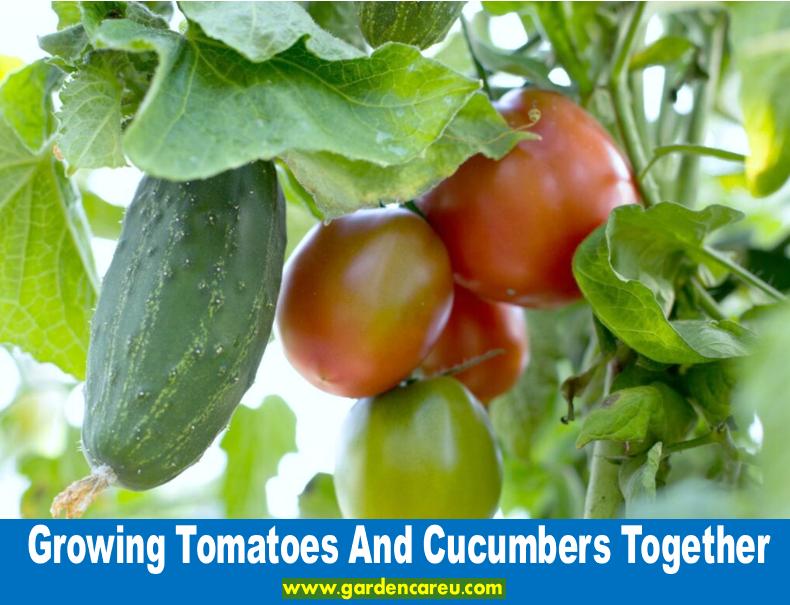Growing Tomatoes And Cucumbers Together: When planting tomatoes and cucumbers, ensure they are spaced at least 2 feet apart. Companion planting tomatoes and cucumbers provides benefits such as pest control and maximizing space usage.
Additionally, both plants have similar sunlight and soil requirements. Growing them together can create a harmonious garden ecosystem while increasing your yield. Proper spacing, trellising, and soil preparation are key factors in cultivating tomatoes and cucumbers nearby.
Avoiding planting certain companions like Brassicas, corn, and fennel near your tomatoes or cucumbers can help prevent competition for nutrients and potential growth issues. Planting tomatoes and cucumbers together can be a rewarding and efficient gardening practice when done thoughtfully and strategically.
[ez-toc]

Companion Planting
Companion planting is cultivating different types of plants together to create mutually beneficial relationships, helping them thrive and promoting a healthy garden ecosystem. When it comes to growing tomatoes and cucumbers together, understanding the concept of companion planting and its benefits is essential.
Understanding The Concept
Understanding the concept of companion planting involves the strategic pairing of plant species to enhance growth and deter pests. When tomatoes and cucumbers are grown together, they complement each other’s needs. Tomatoes act as a natural repellent for pests that commonly affect cucumbers, while cucumbers provide ground cover to reduce water evaporation and prevent soil erosion for tomatoes.
Benefits Of Companion Planting
- Natural Pest Control: Planting tomatoes and cucumbers together discourages pests that specifically target one of the two plants.
- Soil Health Improvement: The combined root systems of tomatoes and cucumbers help enhance soil structure and fertility, promoting overall plant health.
- Space Efficiency: Growing tomatoes and cucumbers together optimizes space usage in the garden, making it ideal for smaller areas.
In conclusion, companion planting tomatoes and cucumbers offers several advantages, creating a sustainable and productive gardening environment.
Optimal Planting Distances
Recommended Spacing
For optimal growth, plant tomatoes at a distance of 18-24 inches apart while allowing 36-48 inches between rows. Cucumbers require 12-24 inches spacing between plants and at least 48-72 inches between rows.
Factors Affecting Planting Distances
Several factors influence the planting distances of tomatoes and cucumbers when grown together. Consider the growth habits, root systems, and potential for competition between the two plants. Additionally, assess the available space in your garden to ensure proper air circulation.
- Sunlight: Both tomatoes and cucumbers require ample sunlight, so ensure they are not overshadowing each other.
- Soil Quality: Good soil drainage is vital for healthy plant growth, so provide adequate spacing to avoid waterlogged conditions.
- Pest Control: Proper spacing aids in pest management by reducing the chance of pests spreading between plants.
Plant tomatoes and cucumbers at the recommended distances to promote optimal growth and yield.
Remember to avoid planting cucumbers next to potatoes, as they are susceptible to similar diseases, and keep tomatoes away from brassicas and fennel to prevent nutrient competition.
Compatible And Incompatible Plants
When growing tomatoes and cucumbers together, it’s important to consider their compatibility and avoid planting them too close. Although tomatoes and cucumbers can be grown together, it’s best to keep them at least 12-18 inches apart to allow for adequate space and airflow, reducing the risk of diseases and pest infestations.
Additionally, it’s important to consider companion planting and avoid co-planting them with incompatible plants like potatoes and fennel, as they can hinder growth and attract pests that may harm both crops.
Best Companion Plants For Tomatoes And Cucumbers
When it comes to growing tomatoes and cucumbers together, it is important to consider their compatibility and the plants that can thrive alongside them. Companion planting is a technique that involves planting specific plants together to promote growth and deter pests.
Let’s explore some of the best companion plants for tomatoes and cucumbers:
- 1. Basil: Basil is an excellent companion for tomatoes and cucumbers as it repels pests like mosquitoes and flies. Plus, it enhances the flavor of tomatoes when grown nearby.
- Marigolds: Marigolds are known for their strong odor, which repels nematodes and other pests that can damage tomatoes and cucumbers. To provide protection, plant marigolds around the perimeter of your garden bed.
- Nasturtiums: Nasturtiums not only add a pop of color to your garden but also act as a natural pesticide, keeping aphids and whiteflies away from your tomato and cucumber plants.
- Mint: Mint is a great companion plant for cucumbers, as it repels aphids and ants that may harm your cucumber plants. Be sure to grow mint in containers to prevent it from spreading and taking over your garden.
- Peppers: Peppers are compatible with tomatoes and cucumbers regarding growth requirements and can help repel pests. Their fiery fruits add a spicy touch to your garden.
Plants To Avoid Planting Near Tomatoes And Cucumbers
While certain plants can be beneficial when grown alongside tomatoes and cucumbers, some plants should be avoided due to their negative effects on growth and development.
Here are some plants to avoid planting near tomatoes and cucumbers:
- 1. Brassicas: Cabbage, broccoli, cauliflower, kale, Brussels sprouts, and kohlrabi can stunt the growth of your tomato plants because they compete for the same nutrients. Keep these plants at a distance from tomatoes and cucumbers.
- Corn: Corn can potentially shade and overcrowd the tomato and cucumber plants, inhibiting their growth. It is best to give these crops their own dedicated space.
- Fennel: Fennel secretes chemicals that can hinder the growth of neighboring plants, including tomatoes and cucumbers. Avoid planting fennel near these crops to ensure their healthy growth.
- Dill: Dill can attract pests, such as tomato hornworms, which may harm tomatoes and cucumbers. It is advisable to keep dill away from your tomato and cucumber plants.
- Potatoes: Potatoes and tomatoes are susceptible to the same diseases, such as blight. Planting them together increases the risk of spreading diseases and should be avoided.
Remember, companion planting is all about finding the right balance and optimizing the growth and health of your plants. By selecting the right companion plants and avoiding incompatible ones, you can create a harmonious and thriving garden bed for your tomatoes and cucumbers.
Caring For Tomatoes And Cucumbers
Planting tomatoes and cucumbers together can be a practical and space-saving approach in the garden, but proper care is essential to ensure a successful harvest. Caring for tomatoes and cucumbers involves attention to watering and fertilizing, as well as effective pest and disease management. Here are some essential tips for nurturing these companion plants.
Watering And Fertilizing Tips
1. Watering: Both tomatoes and cucumbers require consistent moisture, especially during their fruiting stages. Ensure the soil is moist but not waterlogged to support healthy growth and fruit development.
2. Fertilizing: A balanced and nutrient-rich soil is crucial for the optimal growth of tomatoes and cucumbers. Use a high-quality organic fertilizer or compost to provide the necessary nutrients for these plants. Additionally, a foliar spray of diluted compost tea or fish-based fertilizer can help boost their growth.
Pest And Disease Management
1. Companion Planting: Consider interplanting basil, marigolds, or borage alongside tomatoes and cucumbers to deter pests naturally and promote a healthy growing environment.
2. Regular Inspection: Inspect the plants for early signs of pest infestations and diseases. Promptly remove any affected leaves or fruits to prevent the spread of diseases.
3. Organic Pest Control: Use natural pest control methods, such as neem oil or insecticidal soap, to combat common pests like aphids, whiteflies, and caterpillars without harming beneficial insects in the garden.

Frequently Asked Questions Of Growing Tomatoes And Cucumbers Together
Can You Plant Tomatoes And Cucumbers Close Together?
Yes, you can plant tomatoes and cucumbers close together in the garden for optimal use of space and mutual benefits.
What Should Not Be Planted With Tomatoes?
Tomatoes should not be planted with brassicas (cabbage, broccoli, etc. ), corn, fennel, dill, potatoes, eggplant, or walnuts. These plants can stunt tomato growth or attract pests that can harm tomatoes. Cucumbers should not be planted with potatoes or tomatoes because they can spread diseases to each other.
What Not To Plant Next To Cucumbers?
Tomatoes and cucumbers should not be planted next to each other. They attract pests like aphids and whiteflies that can harm both plants. Additionally, cucumbers and potatoes can spread diseases, such as blight, to each other. Avoid planting these combinations to ensure healthy growth.
Can Tomatoes And Cucumbers Grow On The Same Trellis?
Tomatoes and cucumbers can grow on the same trellis, allowing for efficient use of space.
How Far Apart Should Tomatoes And Cucumbers Be Planted?
Tomatoes and cucumbers should be planted at least 24 inches apart to allow enough space for growth and prevent competition for nutrients.
What Should Not Be Planted With Tomatoes?
Avoid planting tomatoes near brassicas (cabbage, broccoli, etc. ), corn, fennel, dill, potatoes, eggplant, and walnuts, as they can stunt tomato growth or attract pests.
Conclusion
When growing tomatoes and cucumbers together, remember to provide adequate space for growth. Consider the compatibility of companion plants to ensure a thriving garden. Following proper spacing guidelines and choosing suitable companions, you can enjoy a fruitful harvest from your tomato and cucumber plants.
Happy gardening!


